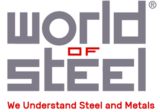What is Non Ferrous Steel Scrap
WHAT IS NON FERROUS STEEL SCRAP?
In metallurgy, a non-ferrous metal is a metal, including alloys, that does not contain iron (ferrite) in appreciable amounts.
Generally more costly than ferrous metals, non-ferrous metals are used because of desirable properties such as low weight (e.g. aluminium), higher conductivity (e.g. copper), non-magnetic property or resistance to corrosion (e.g. zinc).
Some non-ferrous materials are also used in the iron and steel industries. For example, bauxite is used as flux for blast furnaces, while others such as wolframite, pyrolusite and chromite are used in making ferrous alloys.
EXAMPLES OF NON FERROUS METALS
- Important non-ferrous metals include aluminium, copper, lead, nickel, tin, titanium and zinc, and alloys such as brass.
- Precious metals such as gold, silver and platinum and exotic or rare metals such as cobalt, mercury, tungsten, beryllium, bismuth, cerium, cadmium, niobium, indium, gallium, germanium, lithium, selenium, tantalum, tellurium, vanadium, and zirconium are also non-ferrous.
- They are usually obtained through minerals such as sulphides, carbonates, and silicates Non-ferrous metals are usually refined through electrolysis
- Non-ferrous metals were the first metals used by humans for metallurgy. Gold, silver and copper existed in their native crystalline yet metallic form. These crystals, though rare, are enough to attract the attention of humans.
- Nonferrous metals, such as aluminum, copper, lead, nickel, tin, and zinc, do not degrade or lose their chemical properties in the recycling process. As a result, nonferrous metals have the capacity to be recycled an infinite number of times.
